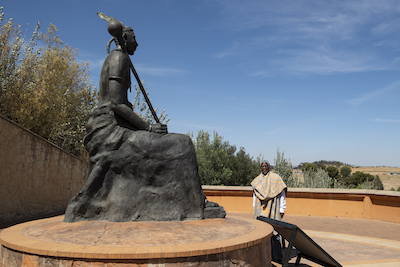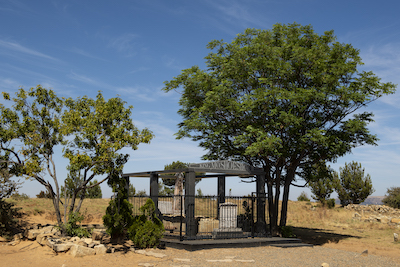
You are here: Explore > Places to Visit > Thaba-Bosiu
Thaba Bosiu lies at the historic and spiritual heart of the Sotho Kingdom. Rising to an altitude of 1,800m only 20km east of Maseru, this near-impregnable sandstone plateau served as the residence and military stronghold of Moshoeshoe I, the kingdom’s founding father, throughout most of his mid-19th century reign.
 Oral tradition has it that Thaba Bosiu - literally ‘Mountain of Night’ - was so named by Moshoeshoe because he and his followers, who arrived there in the chilly midwinter of 1824, made the initial ascent to the plateau after dark. The name also alludes to the belief that the mountain grows taller at night, a legend propagated by Moshoeshoe to discourage his enemies from attempting a nocturnal siege.
Oral tradition has it that Thaba Bosiu - literally ‘Mountain of Night’ - was so named by Moshoeshoe because he and his followers, who arrived there in the chilly midwinter of 1824, made the initial ascent to the plateau after dark. The name also alludes to the belief that the mountain grows taller at night, a legend propagated by Moshoeshoe to discourage his enemies from attempting a nocturnal siege.
Thaba Bosiu is rather low-lying by Lesotho’s lofty standards, but Moshoeshoe, who arrived there in the midst of the Difaqane Wars initiated by King Shaka of the Zulus, was quick to recognise its strengths as a natural fortress. The expansive flat-topped summit is protected on all sides by formidable sandstone cliffs, yet it is watered by half a dozen natural springs and was large enough to hold plenty of livestock and other provisions during an extended siege. As a result, though Thaba Bosiu was attacked on several occasions in the mid-19th century, by both African and European foes, it was never captured and would be abandoned in favour of Maseru only after Moshoeshoe’s death of natural causes in 1870.
Thaba Bosiu is steeped in history. From the Visitor’s Centre at the mountain’s base, a steep and gravelly footpath follows Khebelu Pass to the plateau, passing en route a plaque marking the spot where the Boer leader Louw Wepener (the only invader to ever get close to the summit) was shot dead by Moshoeshoe’s men on 18 August 1865.
 On the plateau itself, Moshoeshoe’s partially restored royal compound comprises five rectangular and circular stone buildings constructed by a Scottish soldier called David Webber who took refuge there in 1839. A short distance away, the tomb of Moshoeshoe I is the centrepiece of a royal cemetery where all his successors, from King Letsie I (died 1891) to King Moshoeshoe II (died 1996) are buried along with various other Sotho royals and dignitaries.
On the plateau itself, Moshoeshoe’s partially restored royal compound comprises five rectangular and circular stone buildings constructed by a Scottish soldier called David Webber who took refuge there in 1839. A short distance away, the tomb of Moshoeshoe I is the centrepiece of a royal cemetery where all his successors, from King Letsie I (died 1891) to King Moshoeshoe II (died 1996) are buried along with various other Sotho royals and dignitaries.
.jpg) The plateau also offers superb views in all directions, the most conspicuous landmark from the summit being Mount Qiloane, a conical sandstone pillar that stands about 1km to the east and whose distinctive shape reputedly inspired the design of the traditional Basotho mokorotlo straw hat.
The plateau also offers superb views in all directions, the most conspicuous landmark from the summit being Mount Qiloane, a conical sandstone pillar that stands about 1km to the east and whose distinctive shape reputedly inspired the design of the traditional Basotho mokorotlo straw hat.
Adjacent to the Visitor’s Centre at the mountain’s base, Thaba Bosiu Cultural Village is an architecturally innovative complex that provides a modern spin on traditional Sotho stone-and-thatch building techniques. In addition to a hotel and restaurant, it incorporates a replica Sotho village of traditional homesteads, and an informative museum dedicated to Moshoeshoe I and various aspects of traditional Sotho culture.
Sleeping: Although plenty of hotels and guesthouses are available in Maseru about 20km to the west, the stone-and-thatch chalets at Thaba Bosiu Cultural Village might be more attractive to those who prefer a more rural setting.
Eating: An international restaurant with thatch roof and terrace seating can be found at Thaba Bosiu Cultural Village almost alongside the Visitor’s Centre.
Access: Thaba Bosiu is about 30-45 minutes’ drive east of central Maseru along the surfaced A2 and B2. It lies a similar distance northeast of Moshoeshoe I International Airport. Regular public transport runs there from Maseru.
Preparations: Solid walking shoes are recommended for the short but steep and gravelly hike to the plateau. A walking stick might also be useful.


